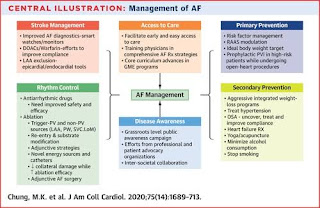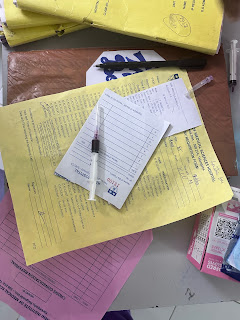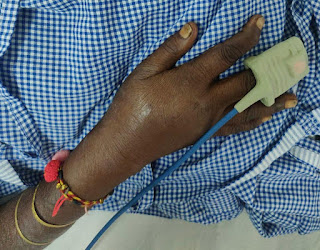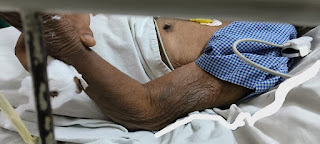4) Case based OSCE along with Bloom's learning levels acheived .
4) Case-based OSCE along with Bloom's learning levels achieved.
TODAYS OSCE:-
Firstly it was in OP where I was assigned a case to be seen on an OP basis
A young male patient was sitting outside opd waiting.
He had a history of falls from a bike 3 days ago and
Had developed pain in the right side of chest and bilateral tmj joint
There was no history of loss of consciousness; seizures; ENT bleeding; bowel incontinence or bladder incontinence
Not a known case of HTN; CAD; DM ; CVA ; TB ; EPILEPSY
ON EXAMINATION:-
Respiratory rate:- 14 CPM
RESPIRATORY EXAMINATION:-
Inspection:- no scars ; sinuses ; engorged veins
Palpation:- equivocal movement of all parts of the chest
Percussion:- resonant note is heard all over
Auscultation:- bilateral air entry present ; NORMAL VESICULAR BREATH SOUNDS ;
DIAGNOSIS:- MUSCULOSKELETAL INJURY SECONDARY TO TRAUMA
( no signs of pneumothorax)
Plan:-
- reassurance
- TAB DOLO 650 mg Po /bd
- Review sos
LEARNING POINTS:-
Examination of the respiratory system
An aid to reducing unnecessary investigations
https://www.ncbi.nlm.nih.gov/pmc/articles/PMC1715093/
Then we forwarded to IPD CASES:-
There in the ICU, I encountered a patient
Who came c/o loss of speech for one month.
the patient was apparently asymptomatic till one month ago, then she was found in an unconscious state on the roadside then she was noticed by the attendees and was taken to the local hospital and treated by a local doctor for 3 daysand then taken to an outside hospital, where CT brain was done=>Ischemic stroke was diagnosed, weakness and loss of speech => after 3-4 days they were transferred to other hospital (financial constraints)=>stayed there for 10 days and her power recovered and speech has improved and was discharged => after 10 days patient power deteriorated with decrease speech and was brought to our hospital.
PAST HISTORY:-
Known case of HTN AND ON AMLODIPINE 5 mg
Not a known case of DM; CAD; Thyroid; TB; or asthma.
PERSONAL HISTORY:-
Diet - mixed
Appetite- normal
Sleep - adequate
Micturition:- Normal
Addictions :- smoking occasional
Allergic history:- No history of any kind of allergies to food/drugs
Family history:- no significant family history
GENERAL EXAMINATION:-
NO PALLOR ; ICTERUS; CLUBBING; CYANOSIS; ; LYMPHADENOPATHY ; EDEMA
TEMPERATURE:- AFEBRILE
PR:98 bpm ; irregularly irregular
BP:100/60 mmHg @ 4ml/hr noradrenaline
RR:28 cpm
GRBS:- 109 mg/dl
SYSTEMIC EXAMINATION:-
CVS:S1 S2+,NO MURMURS
RS:BAE+ ; NVBS ; B/L BASAL CREPTS
P/A:SOFT ; NON TENDER ; NO ORGANOMEGALY
CNS:-
Tone
Right Left
U.L N. Increased
L.L. N. Increased
Power
Right Left
U.L 3/5. 3/5
L.L. 3/5. 3/5
Reflexes
Right left
B ++. ++
T. ++. ++
S. - -
K. ++. ++
A. - -
PLANTAR:- flexor. Extensor
ALTERED SENSORIUM 2 to CHRONIC ISCHEMIC STROKE AT LEFT MCA TERRITORY PERSISTENT, NON-VALVULAR ATRIAL FIBRILLATION WITH FVR 2 to CAD HEART FAILURE WITY PRESERVED EJECTION FRACTION 2' to CAD with HYPOKALEMIA (Resolving) WITH CARDIOGENIC SHOCK WITH HTN SINCE 4 years
MANAGEMENT:-
- RT FEEDS - 4 Th hourly —- water / 4 Th hourly Milk
- INJ NORADRENALINE @4ml/hr IV INFUSION INCREASE OR DECREASE ACCORDING TO MAP; maintain MAP > 65 mmHg
- INJ HEPARIN IV/QID
- TAB ECOSPIRIN AV (75/20) RT /HS
- INJ AMIODARONE 6mg/ml @ 6.3 ml/hr
- SYP POTKLOR 15 ml in one glass of water
- Monitor vitals hourly.
INVESTIGATIONS DONE:-
Questions asked in today’s posts:-
Efficacy of amiodarone? In atrial fibrillation
In amiodarone-treated patients (N = 1,107), freedom from recurrent atrial fibrillation was 84% and 45% at 1 and 5 years, respectively, with no differences according to left ventricular function (P = 0.8754).
Amiodarone's efficacy in maintaining sinus rhythm and reducing the burden of atrial fibrillation is similar in the presence or absence of severe left ventricular dysfunction. Rhythm control with amiodarone is associated with comparable hospitalization and mortality rates to rate control in patients with and without left ventricular dysfunction.
- Remembering:-
The basic history and sequence of events of the patient are remembered
patient was apparently asymptomatic till one month ago, then she was found in an unconscious state while walking and was treated by a local doctor for 3 days and then taken to a outside hospital, where CT brain was done=>Ischemic stroke was diagnosed, weakness and loss of speech => after 3-4 days they were transferred to other hospital (financial constraints)=>stayed there for 10 days and her power recovered and speech has improved and was discharged => after 10 days patient power deteriorated with decrease speech and was brought to our hospital.
PAST HISTORY:-
Known case of HTN AND ON AMLODIPINE 5 mg
- Understanding:-
Understanding the current problem of the patient
And explained the ideas and concepts regarding the patient
- Applying
Based on the history of proper investigations
Hemogram; CUE ; serology
ECG ; CXR ; ultrasound
CT SCAN is done
AND everything is applied to get a proper diagnosis of the patient.
- Analyzing
Based on all the above levels she has Been analyzed properly to get a proper diagnosis for which adequate treatment is being given.
LEARNING POINTS:-
stroke symptoms
https://www.cdc.gov/stroke/signs_symptoms.htm






Comments
Post a Comment